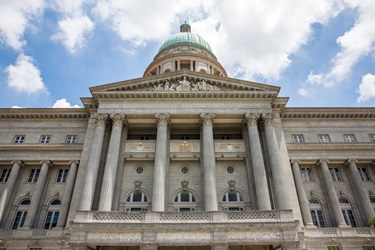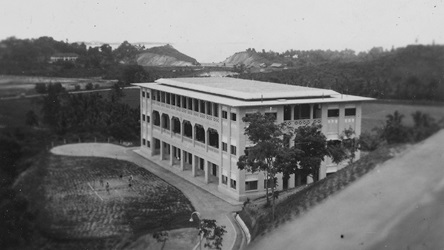Treasured Tales: The Narratives Behind the National Museum's Revamped Spaces

Love in the time of war may seem the stuff of fiction, almost unimaginable given the harsh realities of struggling for survival. Yet at the National Museum, you will find not one but two tales of love that flowered during the Japanese Occupation.
In the Surviving Syonan gallery on the second level, a whole sub-section is dedicated to the love story of Mr Lai Kok Wah, 99, and his wife Mdm Lam Yeok Yin, 94, who narrowly escaped being taken away by Japanese soldiers during the war.
The Lais’ love story started in a bomb shelter. As the shelling screamed overhead, the pair, then both in their twenties, locked eyes across the packed room. From that day on, they began dating. They wed in 1942, with a simple ceremony attended by fewer than 10 people.
In 2012, they celebrated their 70th wedding anniversary and shared their story with The Straits Times and the Chinese press.

Top right: This wedding basin, on loan to the museum, holds great sentimental value for Mdm Lam. It serves as a reminder of the original one she received as a bride. About a month after her wedding, Mdm Lam took her wedding basin to wash at a common area, but was stopped by two Japanese soldiers. They were about to drag her away when her landlady begged them, on her knees, to free her. The soldiers relented, and Mdm Lam was spared.
Bottom right: The Lais registered their marriage six months after their wedding. The wedding certificate, on loan to the museum, contains two errors: Mr Lai’s age was recorded as 31 instead of 26, and his occupation was listed as “fishmonger” instead of the fish wholesaler he was.
Two years later, curator Ms Goh Ngee Hui, who was plumbing the museum’s collection for the Surviving Syonan gallery, came across the documentary Eat to Live: Wartime Recipes. It featured Mr Lai, who told of being a fish wholesaler to the Japanese.
Intrigued, she chased the lead, finding the 2012 Straits Times article and colleagues who linked her up with the couple’s youngest son, Mr Lai Chee Chuen, 60.
“He played a big part in coordinating the loan of artefacts and the visits to their home,” Ms Goh says of the younger Mr Lai, who also helped to interpret for his Cantonese-speaking parents.
Among the many wartime stories that Ms Goh found, she chose to feature the Lais’ for their “vivid memories”. The nonagenarians were willing to share further in a video interview, and had wartime artefacts to complement their story, she adds.
String of connections
For the curators, finding the right artefacts and tracing the stories behind them is often a mix of chance, connections, and courting.
At least that was how a vintage Singer sewing machine came into the possession of the National Museum.
The trusty machine had been a love gift from Mr Joseph Linus to his wife, Grace. During the Second World War, it was left behind when the couple fled their home for safety. As they left, Mr Linus noticed his wife looking back longingly at the Singer.
He later returned, determined to retrieve it for her. Along the way, he saw a man slipping away with a familiar-looking sewing machine in his arms. Instinctively, Mr Linus confronted him, demanding to know how he had got hold of the machine. The man claimed he had bought it – which was unlikely during that time of scarcity.
Surprisingly, Mr Linus had memorised the machine’s serial number and was able to verify that the machine was his. The looter had no choice but to surrender it and Mr Linus was able to return the Singer to his wife, safe and sound.
Decades later, in 2014, the machine was nearly lost again. Ms Elizabeth Mahadevan, the couple’s daughter, had inherited the antique but rarely used it.
One day, a good friend, Ms Kittybond Koo, visited her at home. Ms Koo had known Ms Mahadevan’s husband through her work at the Ministry of Home Affairs’ Heritage Development Unit.
As they chatted, Ms Mahadevan revealed that she was thinking of letting the sewing machine go, but could not bear to. It was then she regaled Ms Koo with the wartime stories her mum had shared.

“I’m the only one [among my siblings] who remembers the [Singer] story because I’m the only one who paid attention!” jokes Ms Mahadevan.
More importantly, she remembered her promise to her mother to never get rid of the sturdy antique.
Ms Koo remembers thinking, “What a waste it would be… there may be many 1940s Singer sewing machines, but none other would have the same story.”
So she called the National Heritage Board, which connected her with the National Museum, and eventually, with the curator Ms Goh.
With a solution to her dilemma found, Ms Mahadevan readily agreed to donate the machine to the museum, as well as copies of her mother’s journal that was replete with war memories.
The three women are now good friends. “When we acquire items, it’s not just about getting the artefacts but also building a relationship,” says Ms Koo.
Family ties

Left: This flexidisc, displayed at the Singapore History Gallery, was a souvenir marking Singapore’s self-government in May 1959. It contains the only known recording of the 1958 version of “Majulah Singapura”. In December 1959, the song became Singapore’s national anthem with changes to the tempo, tune and lyrics.
Other relationships have turned up surprising finds.
When Mr Low Kam Hoong wanted to donate a treasured flexidisc recording of the first-ever version of “Majulah Singapura”, he only had to pick up the phone.
His nephew, Mr Daniel Tham, is a curator at the National Museum.
“My family does not particularly keep old stuff,” says Mr Low, 65. His father had bought the flexidisc as a souvenir and gifted it to him when he was 11.

For Mr Tham, that phone call from his uncle was the first time he heard about the disc, which is now on display at the Singapore History Gallery.
“Not many know that ‘Majulah Singapura’ was not originally our national anthem,” says Mr Tham. The song was written in 1958 by composer Zubir Said for the Singapore City Council, and modified in 1959 to become our national anthem.
Stuff from our past
The revamped permanent galleries showcase more than 1,700 artefacts, including the Surrender Table that was used by the British to sign the surrender document to the Japanese in 1942. The artefacts’ stories and significance are brought to life through interactive displays, multimedia platforms, and even ambient sounds and smells. Yes, you can take in the pong of the once polluted Singapore River, for old time’s sake.

A huge “tree” installation at the Singapore History Gallery invites visitors to rest on a grass verge and enjoy the sounds, smells, images and footage of native flora and fauna. Ever smelled the flowers of a Tembusu tree? Have a try at the scent station here.

This zoetrope in the Growing Up Gallery features a “passing the torch” animation to highlight the legacy of local pioneer sportswomen in the 1950s. It was inspired by Ms Tang Pui Wah, the first female Olympian who represented Singapore at the 1952 Helsinki Olympics. Known as the “Helsinki girl”, she was a role model for other younger female athletes.

Spot our Prime Minister’s boyhood bicycle at the Growing Up Gallery. The 1963 Raleigh “sports” bicycle was a gift from his paternal grandmother when the young Lee Hsien Loong turned 11.
Men in green (right)
This uniform was worn by full-time NSmen until 1979, when the original “Temasek Green” colour was replaced by a darker green, and later, a camouflage print in the 1980s. Mr William Oh received three sets of NS uniforms, and kept this one – used only for special occasions – in tip-top condition, which he recently donated to the museum.

The highlight of the Voices of Singapore gallery is a throwback to the old Jurong open-air drive-in cinema. In the ’70s, it was one of Asia’s largest drive-ins and could host up to 900 vehicles. Here, visitors can sit in “cars” to watch a montage of archival clips.

- POSTED ON
Jan 5, 2016
- TEXT BY
Siti Maziah Masramli
- PHOTOS BY
National Museum of Singapore
-
Out of Office
How To Rekindle Your Love for Your Job
-
Out of Office
Budget Lunches Below $10 For The Budget Season
-
Out of Office
Gillman Barracks: From Colonial To Contemporary Fun









